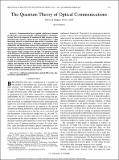| dc.contributor.author | Shapiro, Jeffrey H. | |
| dc.date.accessioned | 2010-04-08T15:21:03Z | |
| dc.date.available | 2010-04-08T15:21:03Z | |
| dc.date.issued | 2009-12 | |
| dc.date.submitted | 2009-05 | |
| dc.identifier.issn | 1077-260X | |
| dc.identifier.uri | http://hdl.handle.net/1721.1/53583 | |
| dc.description.abstract | Communication theory applied to lightwave channels is ordinarily carried out using the semiclassical theory of photodetection. Recent development of nonclassical light sources-whose photodetection statistics require the use of quantum theory-plus increasing interest in optics-based approaches to quantum information processing necessitates a thorough understanding of the similarities and distinctions between the semiclassical and quantum theories of optical communications. This paper is addressed to that need, focusing, for convenience, on the free-space communication channel using Gaussian states of light. The quantum version of the Huygens-Fresnel diffraction integral is reviewed, along with the semiclassical and quantum theories of direct, homodyne, and heterodyne detection. Maximally entangled Gaussian state light is used, in conjunction with quantum photodetection theory, to explain the nonclassical effects seen in Hong-Ou-Mandel interferometry and violation of the Clauser-Horne-Shimony-Holt form of Bell's inequality. The classical information capacities of several bosonic channels are reviewed, and shown to exceed what can be achieved using conventional optical receivers. | en |
| dc.description.sponsorship | Defence Advanced Research Projects Agency. Quantum Sensors Program | en |
| dc.description.sponsorship | Office of Naval Research. Basic Research Challenge Program | en |
| dc.description.sponsorship | W. M. Keck Foundation Center for Quantum Information | en |
| dc.language.iso | en_US | |
| dc.publisher | Institute of Electrical and Electronics Engineers | en |
| dc.relation.isversionof | http://dx.doi.org/10.1109/jstqe.2009.2024959 | en |
| dc.rights | Article is made available in accordance with the publisher's policy and may be subject to US copyright law. Please refer to the publisher's site for terms of use. | en |
| dc.source | IEEE | en |
| dc.subject | quantum theory | en |
| dc.subject | photon beams | en |
| dc.subject | optical diffraction | en |
| dc.subject | Optical communication | en |
| dc.title | The Quantum Theory of Optical Communications | en |
| dc.type | Article | en |
| dc.identifier.citation | Shapiro, J.H. “The Quantum Theory of Optical Communications.” Selected Topics in Quantum Electronics, IEEE Journal of 15.6 (2009): 1547-1569. © 2009 IEEE | en |
| dc.contributor.department | Massachusetts Institute of Technology. Research Laboratory of Electronics | en_US |
| dc.contributor.approver | Shapiro, Jeffrey H. | |
| dc.contributor.mitauthor | Shapiro, Jeffrey H. | |
| dc.relation.journal | IEEE Journal of Selected Topics in Quantum Electronics | en |
| dc.eprint.version | Final published version | en |
| dc.type.uri | http://purl.org/eprint/type/JournalArticle | en |
| eprint.status | http://purl.org/eprint/status/PeerReviewed | en |
| dspace.orderedauthors | Shapiro, J.H. | en |
| dc.identifier.orcid | https://orcid.org/0000-0002-6094-5861 | |
| mit.license | PUBLISHER_POLICY | en |
| mit.metadata.status | Complete | |
